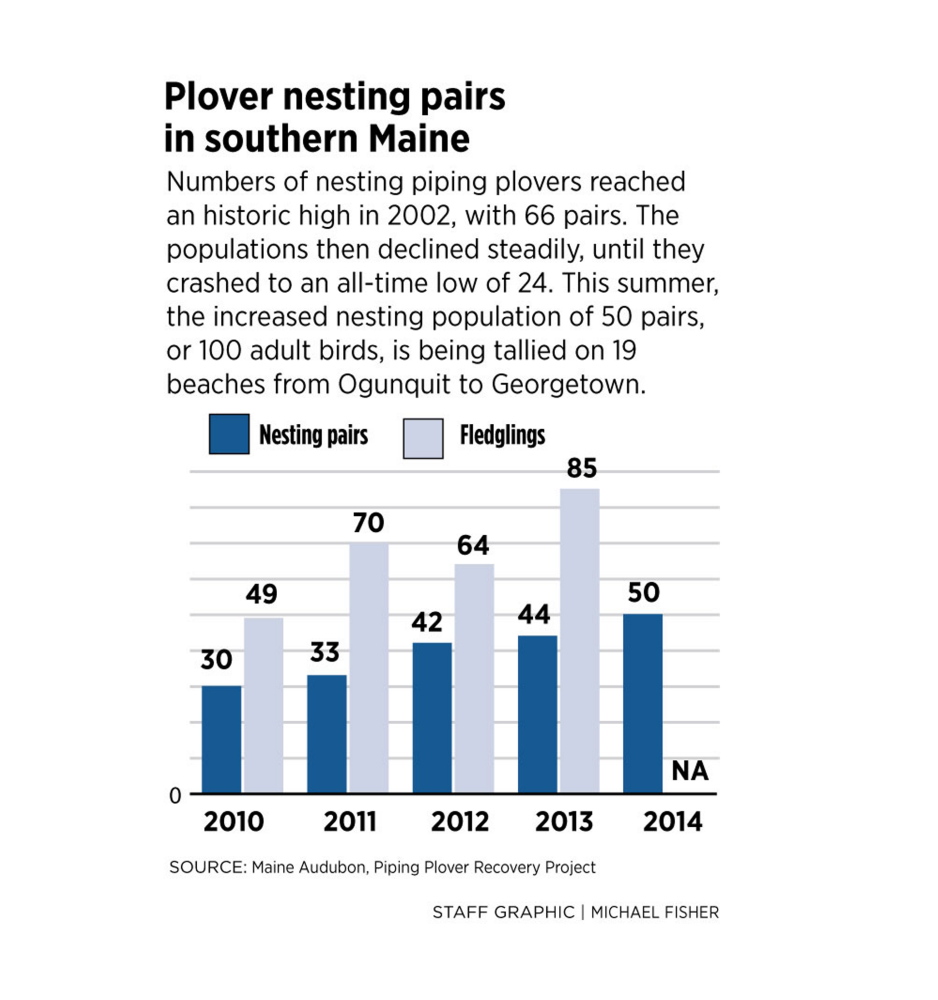Scarborough has double the nesting pairs a year after the endangered birds became the center of a legal battle.
Nesting pairs of rare piping plovers have increased significantly on Maine’s coast this year, say wildlife specialists.
The number of adult birds has reached about 100 statewide, 50 nesting pairs, a benchmark not seen in more than a decade, said Laura Minich Zitske, a wildlife ecologist with Maine Audubon.
The all-time high for plover numbers in Maine occurred in 2002, when 66 nesting pairs were documented, said Zitske. Piping plovers are listed as an endangered species in Maine and as threatened under federal law.
This year’s count reflects a jump of nearly 14 percent over the 44 nests identified last year across the plovers’ nesting habitat in southern Maine, extending from Ogunquit to Georgetown. Many eggs have hatched and chicks are on the move on beaches, but the number of newborns won’t be considered final until the birds are able to fly.
Zitske said one significant increase – from four nests in 2013 to eight surviving so far this year – has occurred in Scarborough, which has been embroiled for nearly a year in a controversy over restrictions for people and their pets to prevent disruption of the nesting birds.
“We’ve never seen the numbers we’re seeing here,” said Town Manager Tom Hall.
He said, “It’s more of a coincidence than anything,” but $22,000 worth of new or expanded initiatives – including a new ordinance governing beach use; the revamping of signs marking nesting areas; additional staffing for education, monitoring and enforcement, and help from more than 30 volunteers to monitor nesting sites – have raised public awareness of the habitat-sensitive needs of the small shorebirds.
Plovers’ pale brown and white coloring and markings camouflage the birds on the beaches where they nest, hiding them from predators. That natural protection also puts the plovers in peril, biologists say. A simple misstep can destroy a nest, shatter an egg or kill a chick.
Weather also can set them back, even though the vicious winter of 2013-14 appears to have left the plovers relatively unscathed.
Though plenty of rain fell this spring in Maine, it didn’t cause the kind of flooding that can wash out the plovers’ nests and batter their shoreline habitat so badly that the birds will not rebuild, said Lindsay Tudor, shorebird biologist with the Maine Department of Inland Fisheries and Wildlife.
In 2008, a year after the Patriot’s Day Storm of 2007 brought astronomical tides, powerful waves and rains that caused widespread coastal flooding, the number of piping plover nests crashed to its lowest point in the last 15 years, with only 24 recorded, Zitske said.
The birds’ recent rebound in Maine is credited in part to increased funding for education and monitoring, cooperation among public agencies and private nonprofit organizations, and broad-based volunteer support in cities and towns, Tudor said.
Most of the plover nests identified this year during nesting season, which starts in early April and can run through August, were found along the long strip of sandy beaches from Cape Elizabeth to Ogunquit, Zitske said.
It’s the sharp rise in activity in Scarborough that has caught many people’s attention.
After an unleashed dog killed a plover chick on Pine Point Beach in July 2013, the U.S. Fish and Wildlife Service found Scarborough in violation of the federal Endangered Species Act and initially fined the town $12,000.
The town negotiated a settlement with the federal agency, which required Scarborough to produce stricter leash-law restrictions and greater protection for the plovers, and reduced the fine to $500.
But the ordinance was overturned in a citizens’ referendum in December. The Town Council deliberated for two more months before passing new regulations in May.
From April 1 through Labor Day, dogs are banned or must be leashed on sections of Higgins, Ferry, Western and Pine Point beaches, where piping plovers have historically been known to nest.
From May 15 to Labor Day, dogs are banned from all beaches in town from 9 a.m. to 5 p.m. From the day after Labor Day until May 14, dogs must be leashed on beaches from 1 to 3 p.m.
Dogs are allowed off leash in non-restricted areas from sunrise to 9 a.m.
The Fish and Wildlife Service has said that Scarborough is still in violation of the settlement agreement and the agency’s guidelines, because there are times and places for dogs to be off leash, said Hall.
But town officials maintain that the new regulations give nesting plovers “superior protection to what (the Fish and Wildlife Service) asked us to do,” he said.
In addition to tightening restrictions, the town has hired staffers to monitor and enforce the new ordinance.
No incidents of chicks being killed have been recorded this year.
Send questions/comments to the editors.




Comments are no longer available on this story